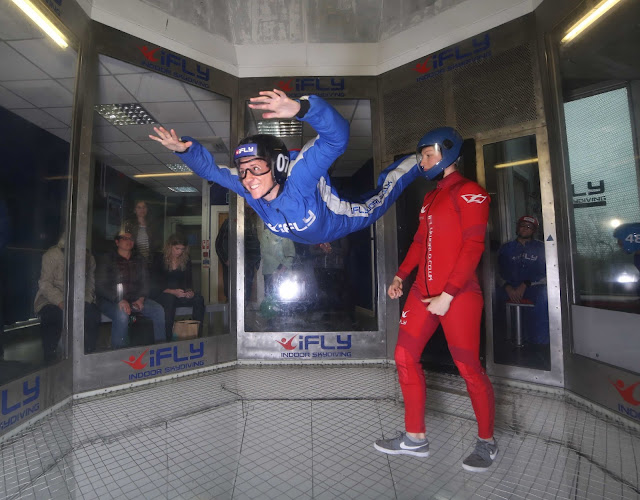Often times when I dream, I am able to fly or bounce really high. I am taking this as a sign that flying should be my superhero power. Teleporting would be a close second but I only think this when I am wide awake. Other choices could be invincible, massive strength, running really fast, but for me flying would it. I have never really considered sky diving as an activity because it is just too scary for me. Jumping out of a plane, depending on parachutes, just seemed a bit risky, even if your first jump is tandem.
As you read last week, I recently made a trip out to Milton Keynes to ski at Snozone, an indoor snowsports facility. While I was looking at a map how to get there, I noticed that next door was iFly, an indoor skydiving facility. iFly is a worldwide company with three locations in the UK, who also operate wind tunnels all over the world.
What is indoor skydiving?
Indoor sky diving using a vertical wind tunnel to create the forces needed for you to be elevated off of the ‘ground’. The bottom of the tunnel wire mesh so the wind can travel through it yet provide a place to stand on. It simulates what it would feel like should you be fall through the sky, but gives you peace of mind because you are never more than 2 stories up in the air. The Milton Keynes tunnel is a wee bit smaller, but the other UK locations have the following stats:
- Max air speed of 180 mph
- Average flying height of 6 feet
- Maximum flying height of 39 feet
- Flight chamber diameter of 14 feet
My experience
I booked in last minute as there was a cancellation. Of course, I was super excited. The facility often books up ahead of time so you need to do a bit of planning if you want to go. iFly ask that you arrive an hour before your flight time to go through the safety process. First, you need to read and sign a declaration saying you release iFly of liability and that you have never has a shoulder dislocation or injury. After I did this, I then checked in at the reception desk, where I was again asked if I had a previous shoulder injury or dislocation. Thirty minutes before flight time, our instructor, Emma, gathered our small group of six flyers and took us into a separate room to watch a safety and instructional video. The video showed us the three important hand signals we would be using in the wind tunnel (chin up, straighten your legs, and relax)) and stated that if you have had a shoulder injury or dis locational,you need to tell the instructor. (See the theme here?). Emma came back in and went through the hand signals again and asked if we had any questions. Half the group were young boys with their moms there to watch. Then it was me and two men about my age.
Emma explained there would be an opportunity for two additional flight options while we are in the wind tunnel for additional cost. The first is spinning up to nearly the top of the tunnel with the instructor holding on to you. This would be in your second fly if you successfully demonstrate control and listening skills in your first fly. On a Saturday afternoon, this was £6. The other option was an additional flight (one minute) in the tunnel for £12. This is only available if there is time left at the end of the session and a pretty steep discount if instead you were to come.back for another visit.
After the video, we got suited up with goggles, helmet, and ear plugs. We also got a jumpsuit. Everything had to be locked up- rings, watches, earrings, so nothing could potentially fall off in the wind tunnel. You are required to wear shoes that tie, like a trainer (sneaker). I had my hiking boots on because of sledging next door which they said would be fine. Guess they are worries that shoes might fall off during your experience.
Once we were suited and booted, we climbed a flight of stairs to the viewing platform. There was a few benches and chairs for people who are with friends and family but not flying. We saw the end of the session before us. Before the group left, the instuctor had two minutes to literally fly all over the tunnel -spiralling down head first, swooping up at the last minute, hovering over the ground. It looked like CGI- the moves he made and the quick changes. It was amazing!
Finally, it was our turn. As a beginner, you get 2 one minute flights. The young boys went first and showed zero fear. At times, they struggled to understand that when Emma corrected one arm position, that meant they should do the same on the other side. As they were small and light, Emma was able to easily move them around so mom could get a good photo and they could try staying afloat near to her.
Then it was my go. I was able to float up well above Emma on my own. I tried to listen as best I could to her feedback and smile for the official camera at the same time. I did wish I had someone there to take photos of videos of me from the viewing platform but i knew i coukd buy the photos and videos that ifly take. Each minute does seems like a long time, especially when your body is bent in a way it isn’t used to and you are trying to stay relaxed as you go higher and higher. I felt like Charlie after he drank the Fizzy Lifting Drink at the Wonka Chocolate Factory.
Of course, I opted to go the top for the bonus spin. It was really fast, which kinda made me dizzy. We went up and down twice and I even drooled (hopefully just due to the force and not my old age).
The young boys each got an extra fly after mom’s approved from across the viewing platform. We were treated to Emma’s flying performance at the end which was spectacular. It really inspired me to develop this as an actual skill. We were told before leaving the tunnel waiting area that we could purchase additional flight packages at a discount that day as a “returning flyer”. I got a really good deal for my next visit which gives me six minutes of flight time. It was emailed to me and expires in three months. I need to book in soon so I don’t miss out!
We walked back down to the ground floor where we turned in our goggles, helmets and jumpsuits. Emma quickly processed our personalalized certification. You get rated on the essential manoeuvres to document how well you did in case you return. Emma told me I was a natural when I started asking her about the physics of the flying- how to turn your hands to start spinning or using leg position to go up and down. I observed her coaching the guy who was a returner, trying to figure some of these things out (the wind is way too loud to hear anything so you mostly rely on hand signals and exaggerated movements). I don’t know if I am really a naturual or just able to follow instructions. If I lived closer, I would consider making this a regular activity. Milton Keynes is just a wee bit far from where I live in London though to train on a regular basis.
All of the iFly staff was super nice. When booking in, I was on my phone on the train so I kept dropping in and out. The team was incredibly patient. Emma impressed me so much that I want to tell the manager. The person at reception said to leave a review on Trip Advisor and mentioned her. Of I did that, she would get a little treat at the end of the month. So I did.
Be sure to tell the truth about previous injuries
The most important thing I would say is to disclose any shoulder injuries you have ever had to your instructor. One of the guys in my group only told Emma about his shoulder dislocation at the age of 15 when we were turning in our equipment. I am a health and safety nut, but I think the fact they ask 3-4 times would clue participants in that this is a big deal.
In short, I loved it so much I bought another jump. If you are curious about skydiving and live in the UK, definitely check out iFly. And ask for Emma.
Thank you to IFly for having me out to try their facility. All opinions and stories of drooling are honest and my own.






